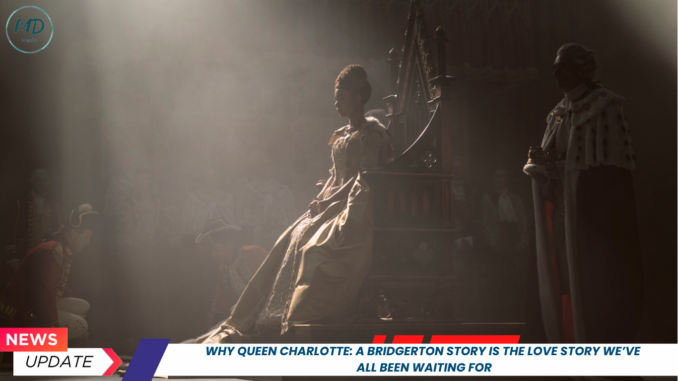
Cue the corsets, the slow-burn romance, and the orchestral version of Beyoncé’s “Deja Vu,” because Bridgerton is back, and it’s as lush as ever.
The latest installment in Shondaland and Netflix’s series based on Julia Quinn’s books is a prequel looking into Queen Charlotte’s (India Amarteifio) youth and her marriage with King George (Corey Mylchreest). In Queen Charlotte: A Bridgerton Story, we travel between the Queen’s past and Bridgerton’s present to witness the politics, romance, and scandal that built a young girl into a ruling monarch. The prequel is Bridgerton‘s most ambitious season yet, including the yearning romance we all adore but also new and darker themes that make the world of the Ton even more compelling.
While Charlotte’s origin story includes fun tidbits, like how she became besties with a young Lady Danbury (Arsema Thomas) and Lady Violet pre-Bridgerton (Connie Jenkins-Greig), it also includes more serious storylines pertaining to her race and her position as the first woman of color to join the British royal family. We begin to understand all the sacrifices she made to stay with George, and how she’s so much more than the schmoozing queen bee deciding the season’s diamond.
Queen Charlotte: A Bridgerton Story is Bridgerton’s most political season yet.

A widespread critique of Bridgerton has been the show’s handling of race, namely its color blindness and negligence toward the actual reality of race in England’s Regency era. In Queen Charlotte: A Bridgerton Story, the show finally tackles race head-on and doesn’t shy away from illustrating the harsher realities for people of color during that time. The latter is mainly explored through the Ton’s reaction to George and Charlotte’s marriage.
With the news of their marriage, Charlotte is alternately tokenized by and segregated from Bridgerton‘s high society. On the one hand, her mother-in-law (Michelle Fairley) treats Charlotte as a poster child for a newly modern royal family and is ready to appropriate her marriage as a sign of their “profound” inclusivity. On the other hand, the Ton is still as racist as ever, shamelessly calling Charlotte “too dark” and reluctant to participate in her royal affairs.
Bridgerton‘s lord and ladies eventually start calling Charlotte’s marriage to George “The Great Experiment.” In their eyes, the question of racial equality solely rests on Charlotte’s ability to prove herself worthy, aka make a bunch of heirs to continue George’s lineage. To them, whether or not The Great Experiment succeeds is purely up to Charlotte. In the prequel’s present timeline, we realize that The Great Experiment is a figurative ghost still haunting an older Charlotte (Golda Rosheuvel), who’s desperate to have grandchildren and show that she’s done her duty for three generations.
While it’s commendable that Bridgerton finally addressed the race of its lead monarch, the navigation of Charlotte’s race is still pretty surface-level and unrealistically idyllic at times, like when Charlotte’s court suggests throwing a ball to finally unite the people — slapping a Band-Aid on centuries of racism with no accountability — and it actually works.
Queen Charlotte: A Bridgerton Story shines with its incredibly tragic, but touching, love story.

Charlotte and George’s relationship is by far the most painful, but most rewarding, courting we’ve seen in Bridgerton so far. Charlotte and George’s love blossoms into something that’s true and untainted by all the outside noise. While the pressures of their world enclose around them, Charlotte and George manage to create their much smaller, intimate world — a safe haven where they only exist, where every touch or stare is a subtle “I got you.”
Their relationship ticks off any trope you’d want from a slow-burn romance. Relentless yearning? Check. An adorable first meet-cute? Check. Great sex? Check. Dramatic fights simmering with a secret urge to just hold each other instead? Check. And to the delight of all hopeless romantics watching Queen Charlotte: A Bridgerton Story, there are even more thrilling relationships strung throughout the show — and yes, one of them is finally queer.
